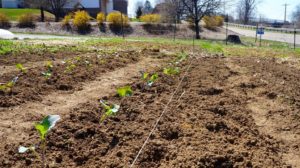
Hardened off kale transplants in the Faith In Action Demonstration Garden will be harvested and donated to the Faith In Action Food Pantry
With the emergence of flowering bulbs, Bradford blossoms, and chirping birds, Grow Your Own members are spending more time outdoors preparing their garden beds for the coming bounty. There are plenty of garden tasks to be done this time of year and Grow Your Own spring vegetable transplants are the perfect size for planting. Still, the regional frost date is still well over a month away. These much anticipated transplants will have higher success rates after being thoroughly hardened off.
Hardening off is the process of acclimating plants grown indoors to outdoor conditions. During hardening off, transplants develop a thicker cuticle layer. The increased cuticle layer protects the plants from damage. Well hardened off plants undergo less transplant shock than those planted immediately in the ground. Tender young plants fresh from indoors can be damaged as wind outdoors kicks up dust which causes many small abrasions on the plant surface. The thicker cuticle layer will protect the plants from these abrasions and the subsequent moisture-loss. The thicker cuticle will also help the plants physically stand up against the wind.
Start hardening off your plants one to two weeks before transplanting them to the garden. Slowly cut back on watering and place plants outside in a sheltered shaded location on a warm day. Keep them out of the wind and away from direct sunlight. Even plants can sunburn under direct light. Do not allow plants to wilt while hardening off, as this means the plants are undergoing too much stress. Start the hardening off process by leaving plants out for an hour or so and increase the exposure each day. Transplants can stay outside on mild nights after they are able to withstand eight or more hours outside without wilting.

Spring greens to be transplanted into the protective shelter of a hoophouse typically don’t need to be hardened off as long, but plants should never wilt.
Greenhouse grown plants are typically grown in warm environments with high humidity. They require longer to harden off than plants grown in hoophouses or other unheated structures. Healthy transplants will have a vigorous root system, will be free of pests and diseases, and will have thick, sturdy stems. Plants that will be planted into more severe environments especially need to be thoroughly hardened off. For example, the first plants of the year will experience colder weather. Surrounding plants may not have emerged yet or may not be tall enough to provide shelter from damaging winds or shade from strong sun. There are garden structures meant to assist the process of hardening off by providing transitionary shelter. Cold frames, cloches, low tunnels, and hoop houses are some examples. Smaller transplants also recover from stress faster than larger transplants, negating the perceived benefit of purchasing a larger plant.
Plants not properly hardened off may end up severely stunted. Early season crops like broccoli, cauliflower, and cabbage may only form tiny heads, the size of a thumb. Many farmers can vouch for this unfortunate truth, but our Grow Your Own members know how to avoid this all too common pitfall. With tomato plants already sitting outside the nursery sections of the large chain stores, our members have the foundational knowledge to avoid the trap and the support to put perfectly sized and healthy transplants in the ground and covered when the time is right, not before.



Bee Keeping… Interested in being part of the bee hives at Emory? Give me a call…
deni